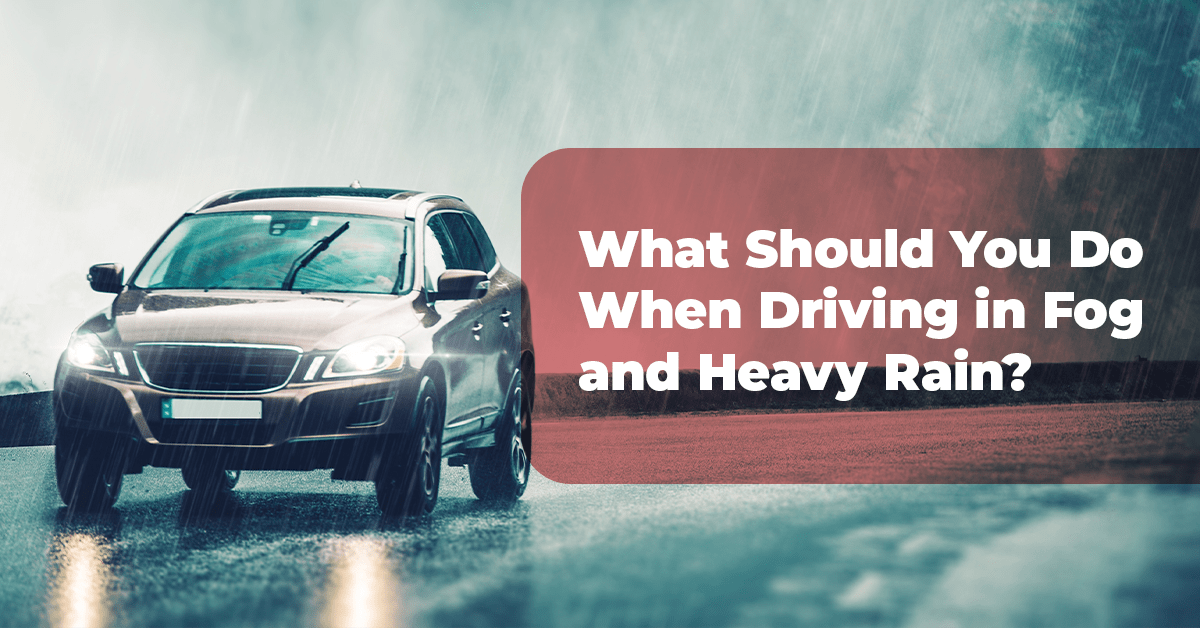Driving in heavy rain and fog can turn a routine trip into a major stress.
Read on and find out how to drive safely in wet weather, fog, hailstorms and even flood water.
Page Contents
- How to Drive Safely in Heavy Rain
- Driving in Wet Weather Checklist
- Does Heavy Rain Affect Stopping Distance?
- How to Drive Safely in Fog
- Should You Reduce Speed Whilst Driving in Fog?
- How to Drive Through Flood Water
- Is There Water in My Engine?
- Should You Drive in a Hailstorm?
- What If Your Car Starts to Slide?
How to Drive Safely in Heavy Rain
To drive safely in the rain, reduce your speed and keep enough distance between your car and the one in front.
You should also use dipped headlights and be aware of any larger vehicles that could spray water and reduce your visibility.
Your steering may feel unresponsive if you are aquaplaning – in which case you should try and ease off the accelerator and slow down gradually.
The road surface can also be slippery if any diesel has spilt, so always drive sensibly just in case.
In the event you break down whilst driving in heavy rain, do not prop the bonnet open whilst you wait for assistance.
When thinking about driving in the rain, you should make sure that your journey is essential before you set off.
If it’s not, consider driving once the weather has brightened up a bit and save yourself the stress.
Driving in Wet Weather Checklist
If you can’t avoid driving in wet weather, make sure you carry out the following checks before you set off:
- Plan your route
- Check traffic and weather
- Pack your emergency car kit
- Check tyre tread
- Check tyre pressure
- Check headlights
- Check fog lights
- Check taillights
- Check windscreen wipers
- Check battery charge
- Ventilate the car
- Test your brakes
Does Heavy Rain Affect Stopping Distance?
Your vehicle’s stopping distance will at least double in the rain, which is why it is so important to drive safely.
How to Drive Safely in Fog
When driving in fog, you should always do the following:
- Keep a safe distance from the vehicle in front
- Use your windscreen wipers
- Use demisters
- Check your mirrors before slowing down
- Take care when emerging from junctions
Be cautious around other drivers who aren’t using their headlights – and don’t accelerate to get away from vehicles that are too close behind you!
The Highway Code states that you must not use your front or rear fog lights unless visibility is seriously reduced.
This is because the lights can dazzle other road users and obscure your brake lights, so make sure you switch them off as soon as visibility improves.
Should You Reduce Speed Whilst Driving in Fog?
You should reduce your speed and keep your distance from the car in front of you when you are driving in fog.
Take care to leave more space when turning or changing lanes, too.
How to Drive Through Flood Water
Driving in flood water can damage your car if you hit objects hidden under the water and can cause damage to your car’s electrical systems.
If you know that flooding is expected, you should move your car to higher ground if possible.
Avoid standing in water and do not drive into flood water that’s moving or more than 10cm deep.
Fast-moving water can sweep your car away – so don’t risk it!
Let approaching cars pass you first and drive slowly to avoid making a bow wave.
If you get stuck in flood water, try to wait in the car and call for help instead of getting out.
In the event you need to leave the vehicle, know that water levels can change quickly.
You should assume that the flood water is contaminated.
Look out for any hazards such as kerbs or maintenance hole covers that may have moved under the water.
Driving fast can cause your tyres to lose contact with the road’s surface and could even cause significant damage if water gets into the engine.
Is There Water in My Engine?
Flooding can cause water damage to vital systems like the engine, brakes, fuel, suspension and exhaust systems.
Water may have got into your engine if you hear a fast-whirring sound when turning the key in the ignition, if you smell petrol or if the car struggles to start.
If you have a flooded car, you should not try to start the engine as hydro locking can occur.
To get water out of your car, open the bonnet, doors and boot.
Take any carpets and loose items out.
You can check the engine bay for water in the oil and air filter – check the dipstick or remove the oil filler cap.
Should You Drive in a Hailstorm?
Driving in a hailstorm can be dangerous, so you should keep your distance from other vehicles.
In some cases, hailstones can be big enough to dent your car body panels and paintwork.
Try and pull over when it is safe to do so and find covered shelter if possible – just don’t shelter under anything that could fall on the car.
If you can’t find somewhere to shelter, it is still better to pull over and be stationary.
What If Your Car Starts to Slide?
If your vehicle starts to slide in wet weather, then you may be experiencing aquaplaning.
It is important that you don’t hit the brakes hard and hold the steering wheel straight, as sudden movements could cause the car to skid.
Gradually ease your foot off the accelerator and slow down, using your brakes gently.






